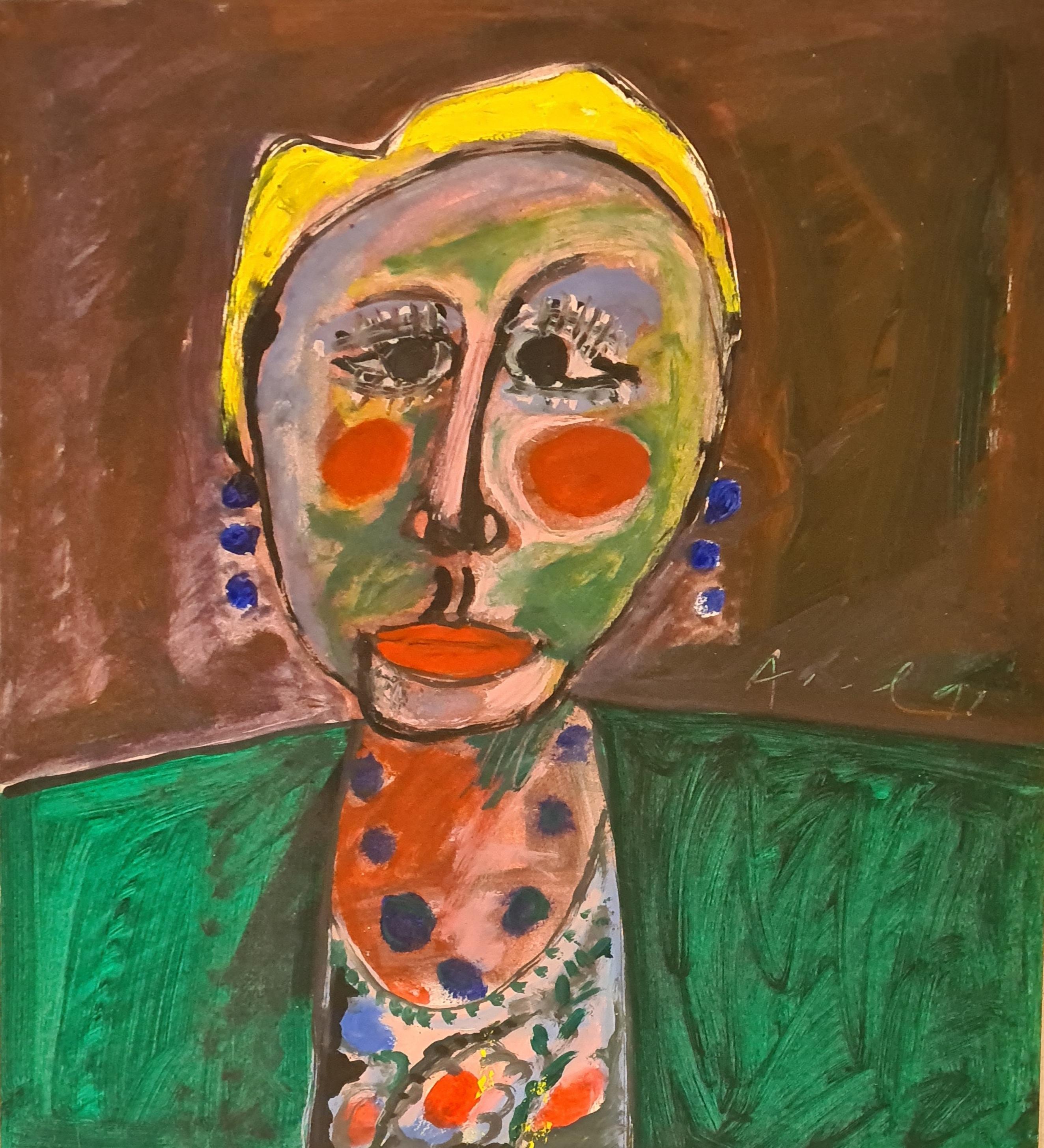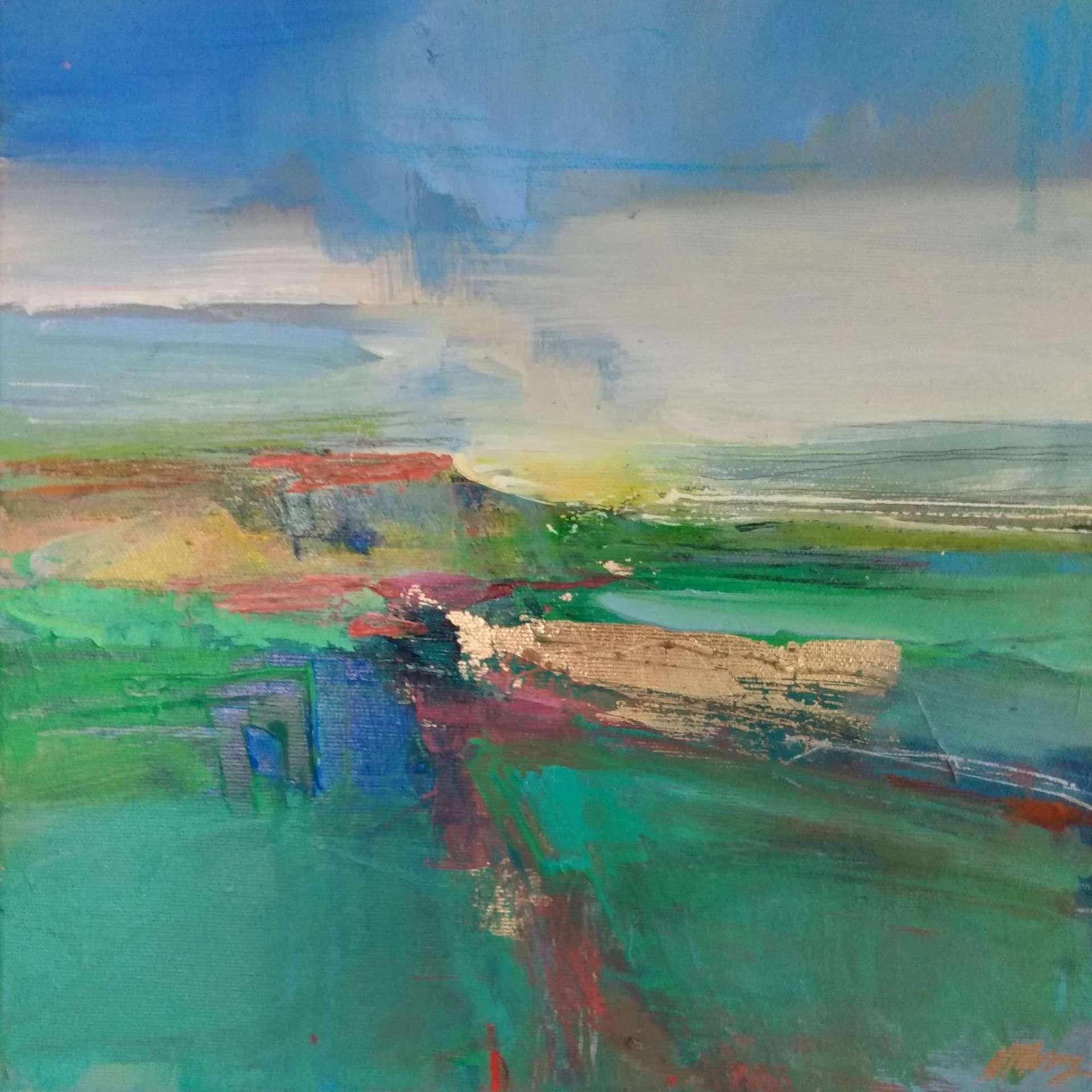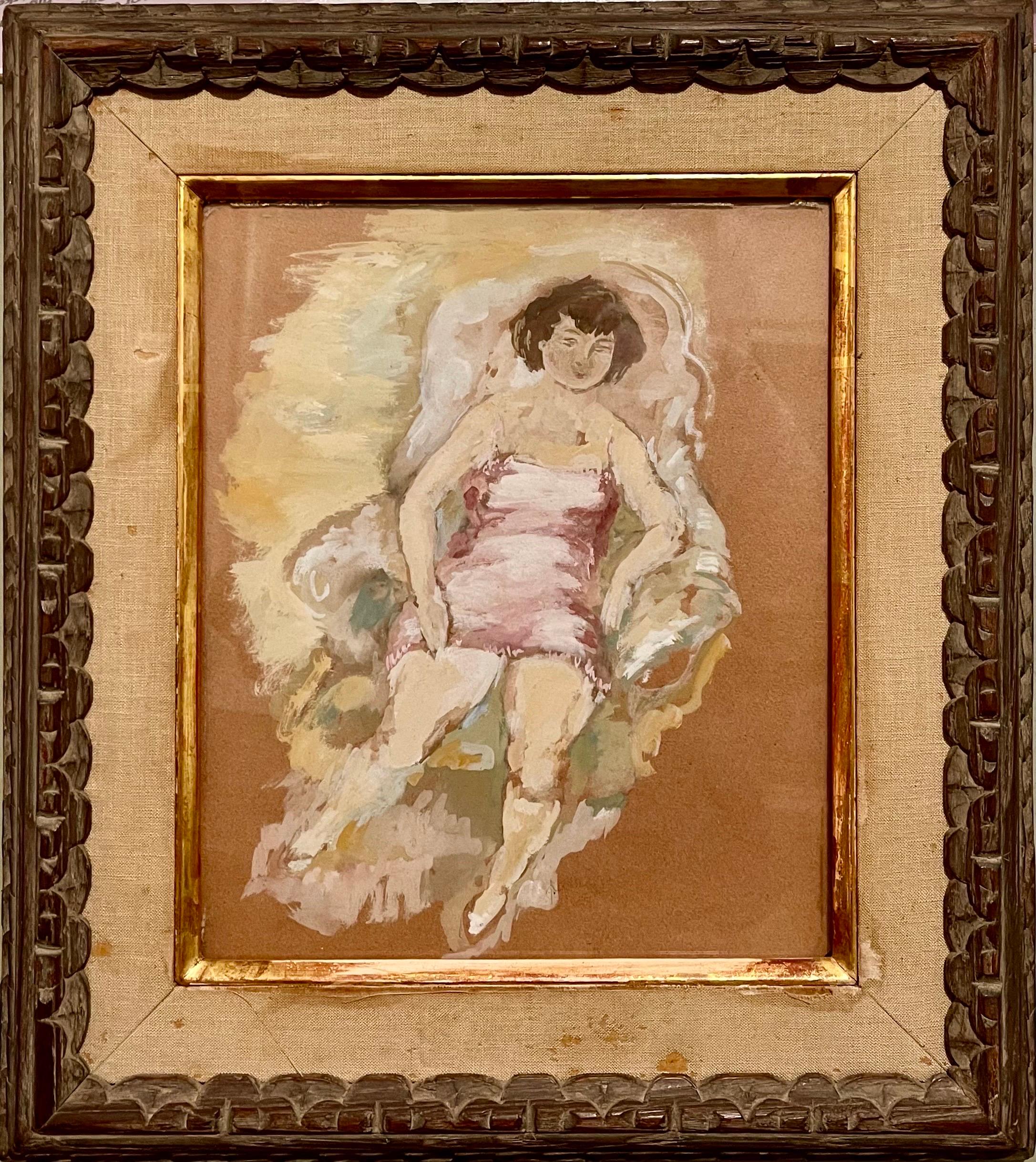Rolph ScarlettGirl with a Flowerc. 1940-1945
c. 1940-1945
About the Item
- Creator:Rolph Scarlett (1891-1984, American)
- Creation Year:c. 1940-1945
- Dimensions:Height: 22.5 in (57.15 cm)Width: 18.25 in (46.36 cm)
- Medium:
- Movement & Style:
- Period:
- Condition:
- Gallery Location:Lawrence, NY
- Reference Number:1stDibs: LU1497213050092
Rolph Scarlett
Rolph Scarlett was a painter of geometric abstraction during the American avant-garde movement of the 1930s and 1940s. Scarlett was born in Guelph, Ontario, Canada in 1889, he left Canada at the age of 18 to go to New York City and returned to Canada during the years of World War I. However, by 1924, Scarlett had established New York City as his home. While he was beginning his career as an abstract painter, he was designing stage scenery for George Bernard Shaw's play, Man and Superman and the Rockettes at Radio City Music Hall. In 1939, while creating the Museum of Non-Objective Painting (later the Solomon R. Guggenheim Museum), Director Hilla Rebay began to take an interest in Scarlett's work. By 1940, he had become the new museum's chief lecturer. By 1953, the Guggenheim owned nearly 60 of his paintings and monoprints. Scarlett later became a resident of the Woodstock art colony for more than 25 years and showed his work in the Woodstock exhibits.
- ShippingRetrieving quote...Ships From: Lawrence, NY
- Return PolicyA return for this item may be initiated within 3 days of delivery.
- Woman with Blue EyesBy Rolph ScarlettLocated in Lawrence, NYGoauche Provenance: Estate of Sam Esses Never afraid of trying new styles, curious and opinionated, constantly engaged with the world around him, Rolph Scarlett more than once proved to be at the artistic zeitgeist in a career that stretched for more than 75 years. Born in 1889, Scarlett had his first retrospective by 1928. He subscribed fully to the modernist credo. Interviewed at the time, he said: "If a futuristic painting...Category
1940s Expressionist Figurative Paintings
MaterialsGouache
- Portrait of a Young ManBy Rolph ScarlettLocated in Lawrence, NYGouache Estate of Samuel Esses Beautifully framed Never afraid of trying new styles, curious and opinionated, constantly engaged with the world around him, Rolph Scarlett more tha...Category
1930s Expressionist Figurative Paintings
MaterialsGouache, Paper
- Chinese Shop Window, Lower East SideBy Gandy BrodieLocated in Lawrence, NYGouache and pastel on paper An artist whose work was simultaneously figurative and abstract, Brodie was praised as "one of the best painters of his generation" by art historian, Mey...Category
1960s Expressionist Abstract Paintings
MaterialsOil Pastel, Gouache
- Tenement StormBy Gandy BrodieLocated in Lawrence, NYGouache and pastel on paper An artist whose work was simultaneously figurative and abstract, Brodie was praised as "one of the best painters of his generation" by art historian, Mey...Category
1960s Expressionist Figurative Paintings
MaterialsGouache, Pastel
- Birch in the ForestBy Gandy BrodieLocated in Lawrence, NYGouache and pastel on paper An artist whose work was simultaneously figurative and abstract, Brodie was praised as "one of the best painters of his generation" by art historian, Mey...Category
1960s Expressionist Abstract Paintings
MaterialsPastel, Gouache
- Gate of Chi ReserveBy Harriette JoffeLocated in Lawrence, NYThis work exhibits many of the themes that preoccupied her during her career, including the repudiation of the distinction between abstraction and figuration, a distinction that preoccupied her mentor Willem De Kooning, the introduction of a female perspective to her art through the reinterpretation of classical art, and the incorporation of a kind of secular, esoteric, materialistic Jewish tradition into her work. Joffe was serious in a way that many artists today are not: she was an artist engaged with the major questions of her time, attuned to the development of her chosen métier, its intrinsic problems and possibilities. Joffe's career spans the post-World War II Abstract Expressionist movement to the present. She is known for her powerful images of women and horses, often intertwined, and representing reciprocal ideas of power, grace and beauty. Indeed, one NYT critic said that she returned the beauty and grace to the female form that De Kooning had taken away. Embraced by the first generation of Abstract Expressionist painters on the East End of Long Island, she represented a link to central figures in the avant-garde of 20th century American art, including such artists as Willem De Kooning (she was a studio assistant), Philip Pavia, Ibram Lassaw, John Little and Balcomb Greene. She did Tai Chi with Elaine De Kooning on the beach in East Hampton. She exhibited nationally in galleries and museums, showing alongside artists such as Roy Lichtenstein, Eric Fischel, Linda Benglis, April Gornick, Larry Rivers, and Jackie Windsor. Joffe also worked with the pioneering Down Under Manhattan Bridge Overpass, or DUMBO, artists finding a voice within the then emerging New York City avant-garde in the 1970s. Joffe's contribution to the history of Abstract Expressionism is featured in the East Hampton Parrish Museum's "oral histories" series. Note: this work was the cover image of the catalogue for the Joffe Retrospective at Lawrence Fine Art...Category
1980s Expressionist Figurative Paintings
MaterialsAcrylic
- Janine, The MuseBy Armand AvrilLocated in Cotignac, FRA vibrant colourful French portrait of Janine, muse of the artist Armand Avril. Signed and dated mid right. Presented in new contemporary framing under glass. Armand Avril (1926) i...Category
Late 20th Century Expressionist Figurative Paintings
MaterialsGouache, Paper, Oil, Acrylic
- Exploring Every Path 4 Magdalena Morey, Original Contemporary Impressionist ArtBy Magdalena MoreyLocated in Deddington, GBMagdalena Morey Exploring Every Path 4 Original Cubist Inspired Landscape Painting Mixed Media on Canvas Canvas Size: H 30cm x W 30cm x D 3.5cm Sold Unframed (Please note that in sit...Category
21st Century and Contemporary Expressionist Figurative Paintings
MaterialsPaper, Pastel, Ink, Acrylic, Watercolor
- Gouache Painting Jules Pascin Hand Signed Woman in Boudoir German ExpressionismBy Jules PascinLocated in Surfside, FLGenre: German Expressionist Subject: Woman Medium: gouache paint Surface: Paper board This is hand signed lower right. Framed it measures 17.25 X 15.5, sheet 12 X 10 This came from a Jewish estate. there was no additional paperwork or provenance. Julius Mordecai Pincas (March 31, 1885 – June 5, 1930), known as Pascin Jules...Category
Early 20th Century Expressionist Figurative Paintings
MaterialsPaper, Cardboard, Gouache
- Mother and Child by Béla Kádár - Work on paperBy Béla Kádár, 1877-1955Located in London, GB*PLEASE NOTE UK BUYERS WILL ONLY PAY 5% VAT ON THIS PURCHASE. Mother and Child by BÉLA KÁDÁR (1877-1955) Gouache on paper 86 x 56.8 cm (33 7/8 x 22 3/8 inches) Signed lower right Kádár Béla This work is accompanied by a certificate of authenticity signed by Gábor Einspach on behalf of The First Hungarian Painting Expert's Office. Provenance Private collection, Israel The Hungarian artist Béla Kádár was born in Budapest in 1877 to a working-class Jewish family. Following his father’s death, he was forced to start working from an early age after only six years to primary schooling and was apprenticed as an iron-turner. In 1902, Kádár attended the Academy of Fine Arts in Budapest. After leaving the Academy, he worked at a mural painting company. Only when he visited Berlin and Paris and being exposed to the avant-garde art of the time, did Kádár direct his attention to painting once again. In 1910, the artist won the Kohner prize, and the same year he was awarded his first solo exhibition at the Hungarian National Gallery. By 1918, Kádár moved to Western Europe. Today he is one of the most famous members of the early twentieth-century Hungarian avant-garde. Over the course of his time living in Berlin, Kádár’s style changed. His expressionistic, graphic works were gradually replaced by paintings that were more romantic and delicate in nature. Incorporating and often synthesising stylistic elements of Cubism, Futurism, Constructivism, Neo-Primitivism and German Expressionism, Kádár’s decorative and metaphysical subject matter was often based upon traditional Hungarian folklore, and his subject-matter became increasingly narrative. His paintings in this period often feature surrealistic dream-like imagery, reminiscent of compositions by Marc Chagall. Despite his variety of subjects, ranging from abstracted figures and landscapes to interiors and objects, his paintings are typically rendered in a bright, jewel-toned palette and feature a fractured approach to rendering space. In 1923 in Berlin, Kádár was invited by Herwath Walden to exhibit at the highly influential Galerie Der Sturm...Category
1930s Expressionist Figurative Paintings
MaterialsGouache
- Gouache Watercolor Painting, Nantucket Harbor Boats American Deaf Modernist ArtBy Robert FreimanLocated in Surfside, FLAbstract harbor scene with boats, in bold, vivid colors on heavy mould made paper. Hand signed and dated, 1980 22 X 30 not frame Robert Freiman, deaf from birth, was born in March 1917 in New York City. He attended an oral program near his home and later transferred to the Lexington School for the Deaf when he was six. Early in his childhood, his love for drawing, painting and studying became apparent, and as an adult, he continued his studies in New York at the National Academy of Design, Pratt Institute, the Art Students League and the Parsons School of Design. In Paris, France he studied at the Ecole des Beaux Arts. Bob Freiman was especially focused on painting portraits and figures in motion in various mediums, especially the mixed-media combination of watercolor, acrylic and pen. Among his subjects were acrobats, ballet dancers, cyclists and other athletes. He as well focused on abstracts for a time, discovering new media in his works with quick brushwork and expressive movements. In the latter part of his career, his style became abstract and surreal with images of metaphysical landscapes with architectural elements such as arches, towers, pyramids and castles floating in the air. The famed art critic Pierre Rouve wrote: “It is therefore refreshing to see them revitalized by the colourist wealth and virile handwriting of Robert Freiman, probably the best American water-colorist since John Marin. He worked in Provincetown and Nantucket and regularly exhibited there. He showed at Doll & Richards gallery of Boston alongside John Chetcuti, Lloyd Goodrich, Tod Lindenmuth, William Meyerowitz, Dwight Shepler, Elizabeth O'Neill Verner, Stanley Woodward, Andrew Wyeth, and others. His work bears the influence of the mid century school of Paris in particular Jean Carzou. He was a regular exhibitor at the Sidewalk Art...Category
1980s Expressionist Figurative Paintings
MaterialsWatercolor, Gouache, Archival Paper
- Barcelona .Original gouache paper paintingBy Agustin RioLocated in CORAL GABLES - MIAMI, FLA. Rio Barcelona .Original gouache paper painting . AGUSTIN RIO ( Barceona 1923 – Barcelona 1997) Formed in Llotja i al Cercle Artístic de Sant Lluc He appeared individually in 195...Category
1980s Expressionist Figurative Paintings
MaterialsGouache, Cardboard






